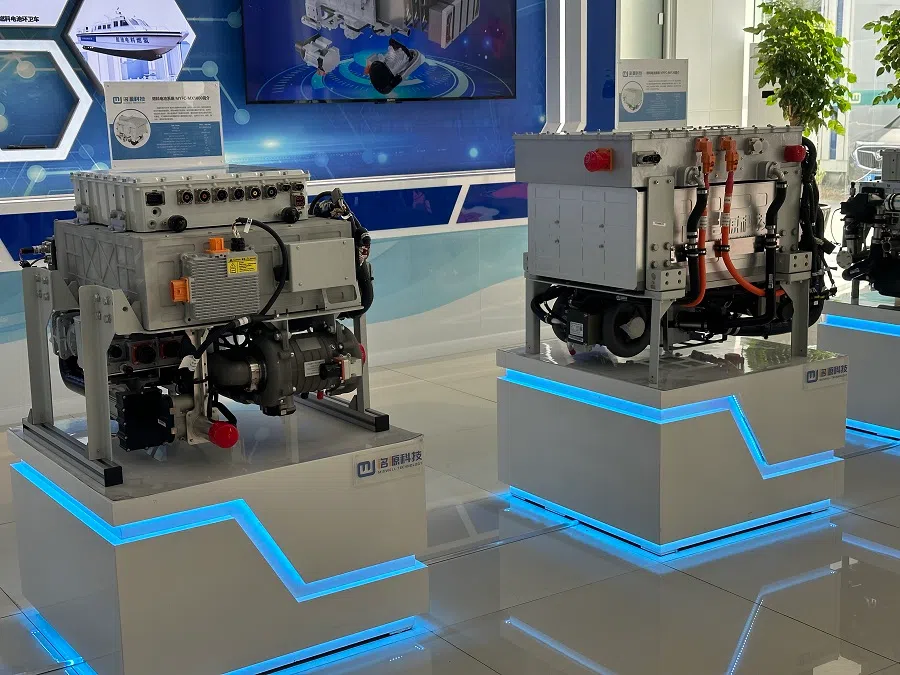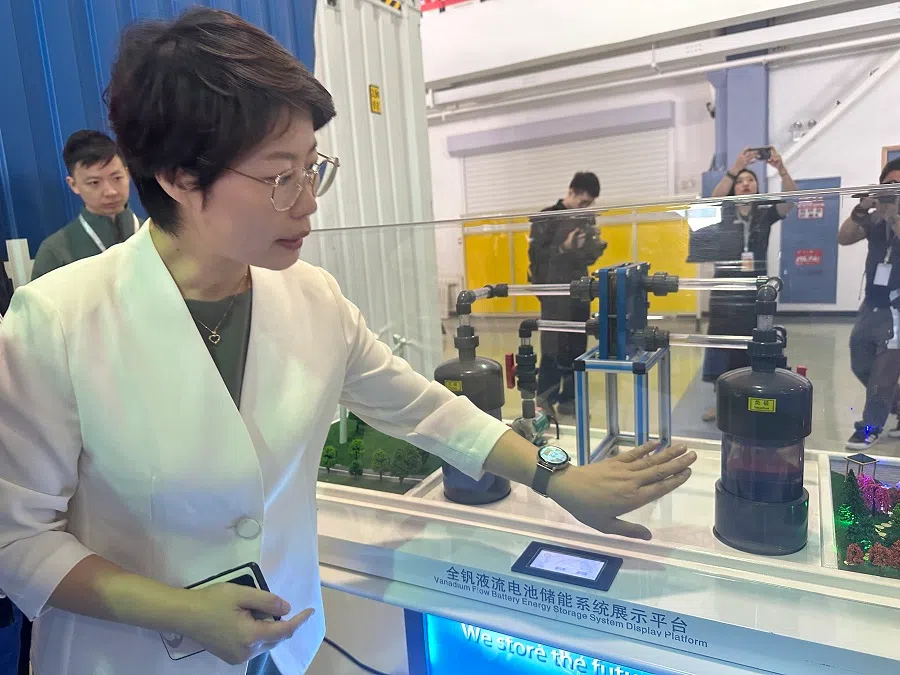Can northeast China revitalise its economy with robotic AI and green energy?
Dalian in China's Liaoning province is not the first place one would think of in relation to the tech industry, but northeast China - despite the gap in its development compared to other parts of China - hopes to ride the wave of tech development, such as in the area of robotics.

(Photos: Daryl Lim/SPH Media, unless otherwise stated)
Walking into the EX Future and Science Museum in Dalian, one feels like they are in a time warp where the past and present are melded together. In one corner, holographic projection technology, lighting and futuristic humanoid robots combine to set a sci-fi movie scene. At the other end of the museum, one steps back in time, encountering humanoid robot wax figures of celebrities from the past.
The robots are produced by intelligent humanoid robot manufacturer EX Robots. In an interview with Lianhe Zaobao, founder Li Boyang said lifelike robots are currently the most complex product in the industry, as such robots have over 140 degrees of freedom from their face to the limbs, which makes them appear more natural than the average robot.

Li added, "Facial expressions are the most complex part of a humanoid robot. Our robots can not only communicate through its voice, it can also express its emotions through its facial expressions and detect the emotions of the person it is interacting with, making it more human-like."
The robots manufactured by EX Robots cost upwards of 1 million RMB (US$137,756), and have already been deployed for use in settings such as smart front desks for public services, smart education, elderly care and unmanned retail stores.
Robot technology on the rise
According to the 2023 report on China's robot technology and industrial development, China's robot technology industry is progressing steadily overall, with significant growth in areas of application. In addition, the key locations for the industry are in the Beijing-Tianjin-Hebei, Yangtze River Delta and the Pearl River Delta areas.
... industrial structure transformation of northeast China has caused the region to miss out many times on the wave of Chinese consumerism in the past 40 years.

The EX Robots operations and R&D headquarters were set up in 2013 in Dalian, Liaoning province. Li does not feel it is a disadvantage to have the company outside of the main cities where China's robot technology industry is concentrated. He said: "Liaoning has a solid industrial base, with many talents in the field of machinery automation and software development."
Emerging industries like EX Robots are one of the attempts to transform the industrial structure of northeast China. The three northeastern provinces of Liaoning, Heilongjiang and Jilin have long been a key agricultural base for China, but with the development of the market economy, the region's traditional development model and mono-industrial structure have left the local economy in dire straits.
Northeast China lagging behind
Li Kai, a professor at the School of Business Administration at Northeastern University and vice-dean of the Northeastern Center for Revitalisation Research (中国东北振兴研究院), said in an interview that the slow-paced industrial structure transformation of northeast China has caused the region to miss out many times on the wave of Chinese consumerism in the past 40 years.
He cited: "From the textile and clothing industry, to the home appliance industry, and the subsequent electronics era with digital devices and internet technology companies - when it comes to all these popular consumer products, there is hardly a trace of companies from northeast China."
...in 2022, the total GDP of the three northeastern provinces was 5.79 trillion RMB, just 45% of the GDP of Guangdong province alone.
In an effort to reverse the development woes in northeast China, in 2003, Chinese officials first introduced a revitalisation policy for the region, seeking to spur economic growth in the region through measures such as tweaking the industry structure. However, because economic development in the three northeastern provinces still lags behind other major areas in China, there are doubts about the efficacy of the revitalisation strategy.

Official statistics showed that in 2022, the total GDP of the three northeastern provinces was 5.79 trillion RMB, just 45% of the GDP of Guangdong province alone. Per capita GDP for northeast China was 59,556 RMB, significantly behind the national average of 85,698 RMB.
Twenty years after the revitalisation plans for northeast China were implemented, the authorities are still actively trying to push through the strategy. At a conference in Harbin, Heilongjiang province in early September, Chinese President Xi Jinping emphasised that the comprehensive revitalisation of northeast China is currently facing new major opportunities, and proposed to promote industrial innovation with scientific and technological innovation to accelerate building a modern industrial system with the characteristics and strengths of northeastern China.
In mid-September, China's State Council Information Office invited 19 local and foreign media outlets to visit Liaoning for a better understanding of the development of emerging industries in the area. Apart from visiting the EX robot museum, the press corps also toured local enterprises involved in new energy.
Industrial development in northeast China
Located within the Dalian Free Trade Zone, Mixwell Technology, founded in 2016, is a high-tech enterprise dedicated to the hydrogen energy and fuel cell industries. Mixwell Technology General Manager Ji Guancheng told reporters that hydrogen energy is an important clean energy, and that the hydrogen fuel cells and hydrogen generators developed by the company are currently used in various applications such as transportation and industrial electricity generation.

He said, "We have delivered over 100 generators to clients and powered devices over millions of kilometres. But this is not a particularly large number, because this technology and industry is still in its very early stages."
Due to the prolonged weakness of the economy and a decreasing ability to attract talent, northeast China is currently caught in a vicious cycle of population exodus and economic decline. However, there are signs that the situation is slowly improving.
Mixwell Technology has over 80 employees, of which 80% are in research and development (R&D). Ji said besides local government support for the hydrogen energy industry, some academic institutions and research institutes in Dalian are also deeply invested in the R&D of these technologies. He said, "Dalian has distinct advantages in terms of its R&D base and human resources when it comes to product development."
Wang Xiaoli, general manager of vanadium flow battery giant Dalian Rongke Power Co Ltd, said the company's cooperation with the Dalian Institute of Chemical Physics has provided strong support for energy-technology innovation.

Established in 2008, Dalian Rongke Power manufactures vanadium products and all-vanadium flow battery energy storage systems, and employs about 600 employees in its vanadium flow battery business. The company raised over 1 billion RMB in a funding round in April, which it will use to fund R&D and expand its production capacity.
Wang said that the company plans to build a bigger R&D centre and double the number of technical staff: "Graduates from Dalian Vocational & Technical College meet our requirements but we also conduct in-house training for engineers from elsewhere. Skills matching won't be too big of a problem."
Professor Li Kai of Northeastern University felt that northeast China has taken advantage of the new prospects brought about by China's new technology revolution, whether it be in the development of robotic artificial intelligence or green sectors connected to new energy sources. However, he conceded that on a national level, the size of individual industries in northeast China is still quite small. Also, the region is more of a follower than a leader in technology.
In his view, while northeast China is not yet prosperous, there is no doubt that its local development has entered a new phase. He said, "As long as we continue to work hard, there is hope that we will be able to keep pace with the country's development. While we may not be the best, at least we are not lagging behind."
This article was first published in Lianhe Zaobao as "大连要抓住新一轮科技革命新机遇".



![[Big read] China’s 10 trillion RMB debt clean-up falls short](https://cassette.sphdigital.com.sg/image/thinkchina/d08cfc72b13782693c25f2fcbf886fa7673723efca260881e7086211b082e66c)

